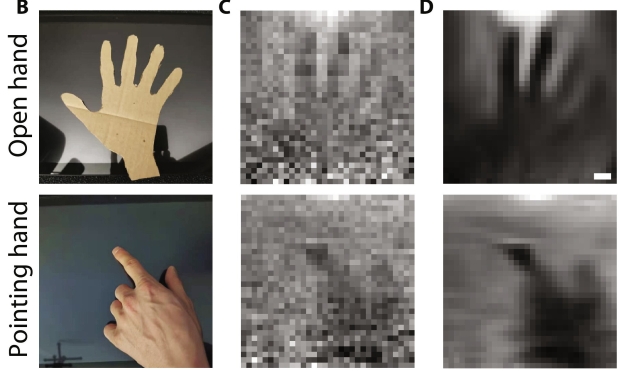If you were worried about your webcam being a privacy threat, well, here's some bad news - there's something else to be concerned about that snoopers could leverage on your devices, namely the ambient light sensor.

'B' is the target hand, 'C' is the recovered image via direct inverse transform, and 'D' is the final recovered image by the researcher's inversion algorithm (Image Credit: MIT / Science Advances)
These light sensors are present with many pieces of hardware - from phones and tablets through to laptops, or indeed TVs - and as the name suggests, they detect ambient light levels in order to adjust screen brightness appropriately.
However, there's a dark side to the light sensor, in that it can be compromised to spy on you, rather like a webcam (which these sensors are often placed near in laptops), if not to quite the same extent in terms of the invasion of your privacy.
The concept of ambient light sensor exploitation was detailed in a paper from scientists at MIT published in Science Advances (spotted by Tom's Hardware).
In fact, leveraging a light sensor to compromise the user of a device has been discussed and explored before, but the researchers from MIT have taken a new approach, developing a method using an active light source (the display) in conjunction with the sensor.
The researchers explain that by using their method it's possible to discern the position and shape of a hand, and gestures made by that hand. It's also possible to pick up on the presence of the user's face, too.
In short, this is a way of using the light sensor to capture images of someone in front of their device - or indeed their camera, even if that camera is shuttered or otherwise covered.
Unlike a webcam, the sensor doesn't have privacy features like said shutter, and is categorized as a low-risk component by device makers, so it's permission-free. All of which makes it ripe for exploitation, of course.
Producing the image from the data gathered from the sensor required a whole lot of tricky maths, along with AI and image processing.
Of course, there are caveats here, and every device's relative risk and exposure to this kind of spying method is different. A lot depends on the specs of the light sensor and indeed the level of screen brightness illuminating the surroundings.
However, the worry is that this kind of avenue for exploitation could be further honed and hackers might have a viable way of spying on you, even if you think you're protected with your shuttered (or taped over) webcam.
The researchers are highlighting the need to look into the likes of on-device permissions for light sensors, or indeed the positioning of the sensor - not right at the front, next to the camera - in order to cut off potential exploits before nefarious types get round to concocting them. That's the hope, anyway.




